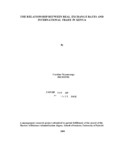| dc.description.abstract | Since time in memorial, many countries including Kenya, have been seeking ways of
strengthening international trade and its benefits and this has attracted researchers in both
academia and policy-making. The relationship between the real exchange rate and
international trade has generated much interest, and thus an overview of the theoretical and
empirical literature in various countries however does provide us with a definitive answer
one can pin down between the relationship of the real exchange rate and international
trade especially after the breakdown of the Bretton Woods system of fixed exchange rates.
This study therefore examined the significant relationship between the real exchange rate
and international trade in Kenya. This paper provides an extensive survey of the literature
on the real exchange rate and trade, examining both the theory that underlies the work in
this area and the results of empirical studies published.
In the methodology the study utilized secondary data on an annual basis for the period 1993
to 2007. The paper utilized both descriptive analysis and inferential statistics to examine
the relationship between the real exchange rates and international trade. The Pearson's
product moment method of con-elation was used to estimate the parameters and the
ordinary least squares method was used for further analysis, in order to determine the
significance of the contribution of the specific variables to the export and import volumes.
By examining exports and imports in Kenya for the period 1993-2007, the study found
that the relationship of the real exchange rate and international trade had been
exaggerated. It was concluded that although there was a relationship between the RER,
exports and imports in Kenya, the relationship was insignificant. The shilling's recent
volatility did not appear to have significantly influenced Kenya's exports and imports.
However like studies of similar nature, this study acknowledged that other factors like GDP
play a vital role in influencing exports and imports. These results arguably point out several
issues of policy concern and call for a rethinking of the strategies practiced in a number of
countries of manipulating RER in an effort to enhance International trade. The study
suggests that the government should concentrate on improving GDP which is a much more
important indicator when compared to RER in the determination of international trade. | en_US |



